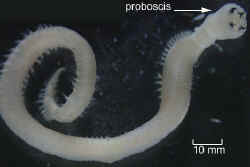 General Feature
General Feature
Glyceridae mostly burrow in sandy substrates by means of
an eversible probosics.
Glyceridae are very active worms. When they are dug out,
they lash about vigorously and shoot out a probosics almost half as long
as the body in an attacking mode. At the tip of the proboscis there are
well developed jaws.
Most species are predators or carnivores.


Whole segment
